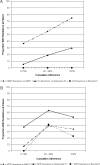Antiretroviral medication adherence and class- specific resistance in a large prospective clinical trial
- PMID: 20099399
- PMCID: PMC2886717
- DOI: 10.1097/qad.0b013e328335cd8a
Antiretroviral medication adherence and class- specific resistance in a large prospective clinical trial
Abstract
Objective: To assess the association between adherence to antiretroviral therapy and the presence of class-specific antiretroviral medication resistance.
Design: Secondary analysis of prospective clinical trial data.
Methods: Participants randomized to the protease inhibitor or nonnucleoside reverse transcriptase inhibitor (NNRTI) strategies of the Community Programs for Clinical Research on AIDS (CPCRA) Flexible Initial Retrovirus Suppressive Therapies (FIRST) Study were included. Adherence was measured by 7-day self-report. Virological failure was defined as an HIV-RNA more than 1000 at or after 4 months. The association between cumulative adherence and the development of class-specific genotypic resistance was assessed by Cox regression analysis.
Results: Included were 457 and 446 antiretroviral-naive participants on the protease inhibitor and NNRTI strategies, respectively. The median time to initial virological failure in the protease inhibitor strategy was 1.2 years; 135 (30%) individuals failed with resistance. The median time to initial virological failure in the NNRTI strategy was 3.0 years; 127 (28%) failed with resistance. No association was found between cumulative adherence and protease inhibitor resistance [hazard ratio 1.1, 95% confidence interval (CI) 0.9-1.4 per 10% lower adherence]. However, lower cumulative adherence was associated with an increased risk of NNRTI resistance at initial virological failure (hazard ratio 1.2, 95% CI 1.1-1.3 per 10% lower adherence). In both strategies, lower cumulative adherence was associated with an increased risk of nucleoside reverse transcriptase inhibitor (NRTI) resistance at initial virological failure.
Conclusion: Adherence-resistance relationships are class-specific. For NRTIs and NNRTIs, initial virological failure with resistance is more likely at lower levels of cumulative adherence.
Figures


References
-
- Bangsberg DR, Perry S, Charlebois ED, Clark RA, Roberston M, Zolopa AR, et al. Non-adherence to highly active antiretroviral therapy predicts progression to AIDS. AIDS. 2001;15:1181–3. - PubMed
-
- Low-Beer S, Yip B, O'Shaughnessy MV, Hogg RS, Montaner JS. Adherence to triple therapy and viral load response. J Acquir Immune Defic Syndr. 2000;23:360–1. - PubMed
-
- Paterson DL, Swindells S, Mohr J, Brester M, Vergis EN, Squier C, et al. Adherence to protease inhibitor therapy and outcomes in patients with HIV infection. Ann Intern Med. 2000;133:21–30. - PubMed
-
- Mannheimer S, Friedland G, Matts J, Child C, Chesney M. The consistency of adherence to antiretroviral therapy predicts biologic outcomes for human immunodeficiency virus-infected persons in clinical trials. Clin Infect Dis. 2002;34:1115–21. - PubMed
-
- Clavel F, Hance AJ. HIV drug resistance. N Engl J Med. 2004;350:1023–35. - PubMed
Publication types
MeSH terms
Substances
Grants and funding
LinkOut - more resources
Full Text Sources
Other Literature Sources
Medical

